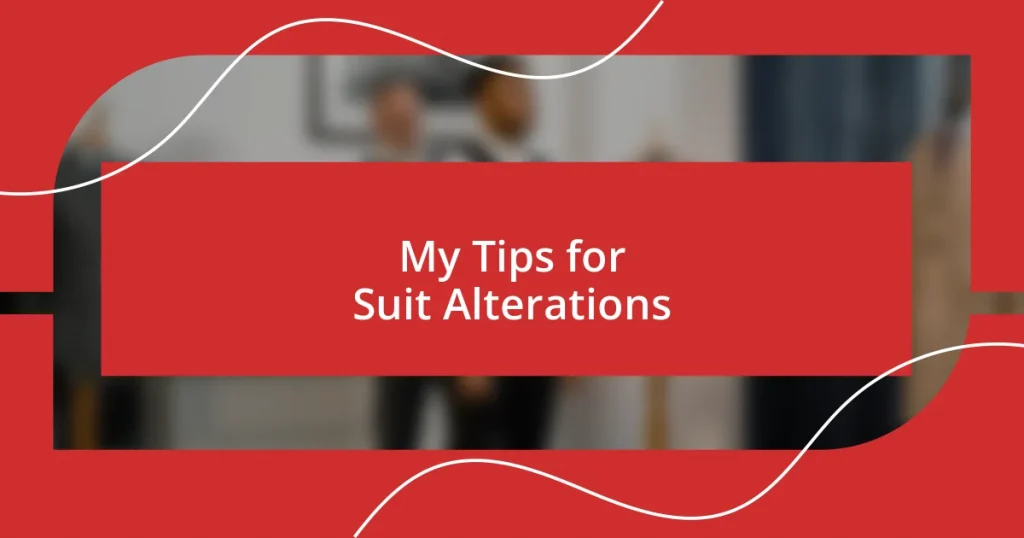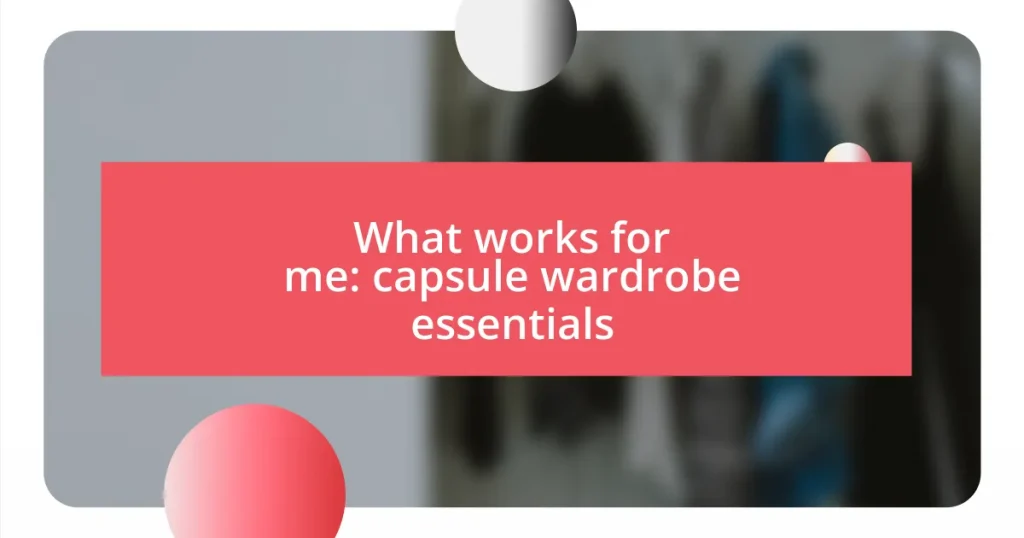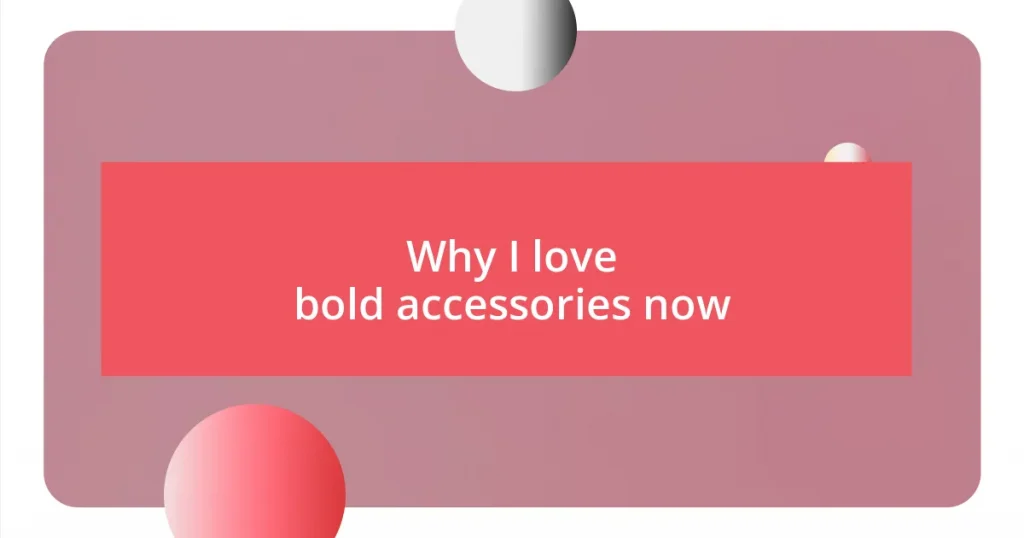Key takeaways:
- Understanding the specifics of suit alterations, like sleeve length and waist suppression, can dramatically enhance fit and confidence.
- Finding a skilled tailor involves seeking recommendations, observing the shop’s environment, and ensuring clear communication of your alteration needs.
- Budgeting for alterations should account for potential unforeseen costs, emphasizing the long-term investment in quality tailoring over time.
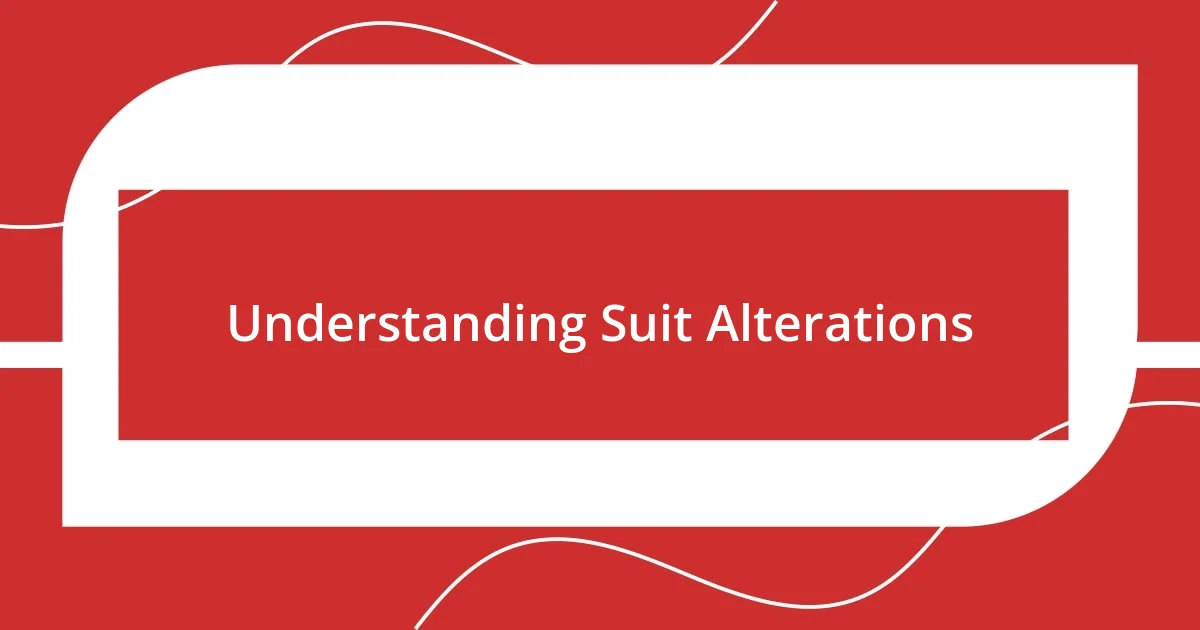
Understanding Suit Alterations
When it comes to suit alterations, understanding the nuances can make a world of difference in how a suit fits and feels. I remember the first time I got a suit tailored; the transformation was incredible. Suddenly, I felt confident, like I was in a suit made just for me, which made me question—how many people are missing out on that experience simply because they don’t realize the potential of proper alterations?
The key to a perfectly tailored suit lies in the specifics. From adjusting the sleeves to ensuring the jacket hugs the shoulders just right, every detail counts. I’ve often found that even the smallest tweaks can elevate a suit from ordinary to extraordinary. Have you ever worn a suit that just felt “off”? It’s that uncomfortable feeling that makes you think, “What if I had just taken the time to tailor it?”
Also, it’s essential to recognize that not all suits are created equal. Fabrics and styles can dramatically affect how a suit can be altered. For instance, I once had a gorgeous wool suit that needed a few adjustments, but the tailor advised against making certain changes due to the fabric type. That taught me the importance of consulting with a knowledgeable professional before jumping into any alterations. It’s a partnership that can yield amazing results when both parties are on the same page.
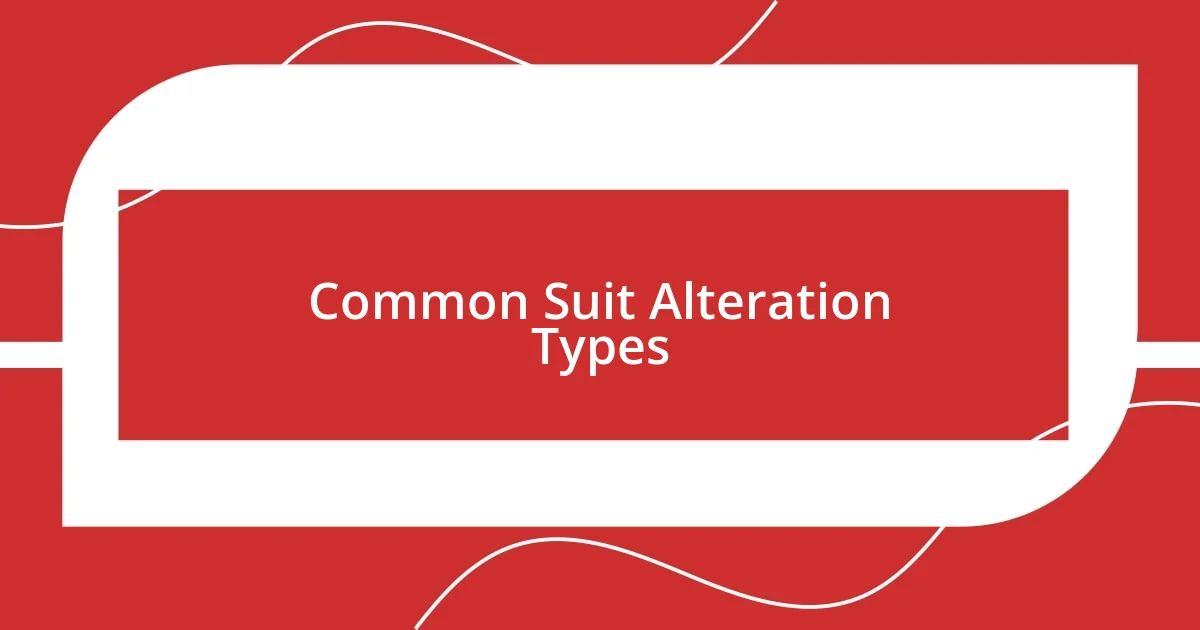
Common Suit Alteration Types
When I think about common suit alterations, a few key changes come to mind that can truly transform your fit. Personally, I’ve experienced the relief of getting my suit sleeves shortened. I vividly recall wearing a beautiful jacket that looked great but had sleeves dragging past my cuffs—every time I moved, it felt awkward. After a simple alteration, it was as if the suit was tailor-made for my frame.
Here are several common suit alteration types that can enhance fit and comfort:
- Sleeve Length: Adjusting sleeve length for a polished look.
- Jacket Length: Shortening or lengthening the jacket to hit at the right spot.
- Waist Suppression: Tapering the body of the jacket for a more tailored silhouette.
- Trouser Hem: Altering the length of trousers for an ideal break.
- Shoulder Adjustment: Making subtle changes to ensure the shoulders fit snugly.
- Pant Waist Adjustment: Taking in or letting out the waist for a comfortable fit.
Each alteration serves a purpose, and I’ve learned the value of consulting with my tailor about the best options for my body type. There’s nothing quite like the feeling of wearing a suit that fits just right—it’s empowering, almost like wearing a suit of armor that allows me to face the world with confidence.
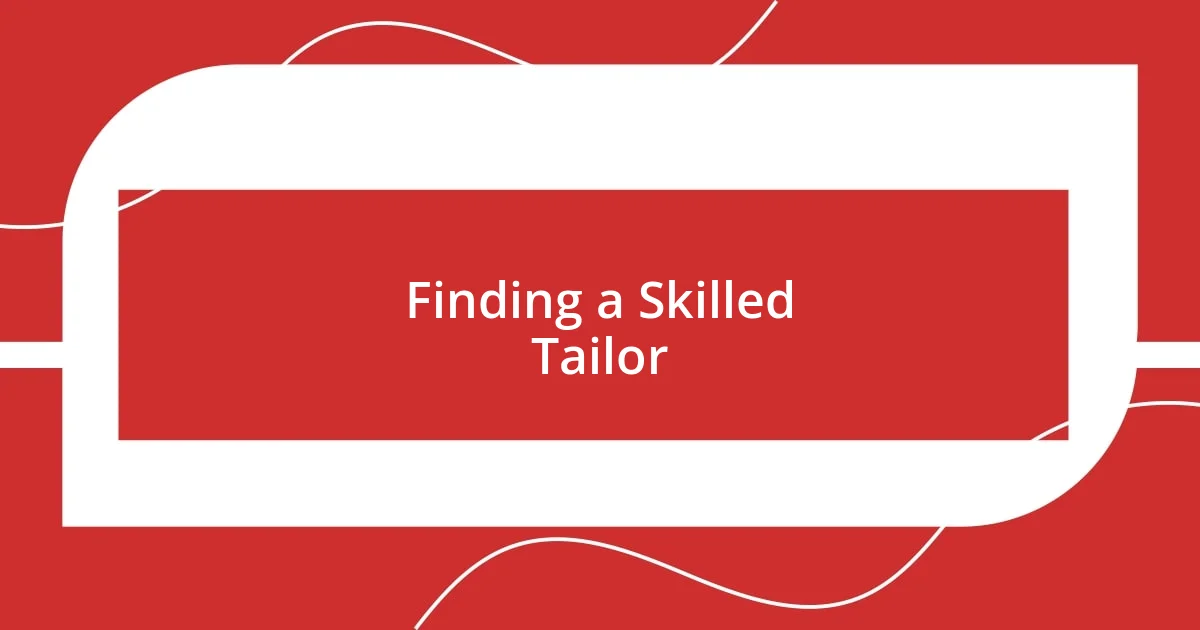
Finding a Skilled Tailor
Finding a skilled tailor is crucial for achieving that perfect fit that makes a suit feel tailored just for you. I always recommend starting by asking friends or colleagues for recommendations. Personally, my best experience was when a coworker referred me to a tailor who not only understood my style but also took the time to explain the alterations needed for my body type. It’s that personal touch and understanding that can turn an ordinary suit into a standout piece.
Additionally, visiting a tailor’s shop can tell you so much about their skill level. I often gauge the atmosphere and cleanliness of the shop; a well-organized space with quality fabric swatches tends to indicate a reputable tailor. On one occasion, I noticed that the tailor had several suits pinned up, reflecting the different body types and styles he worked on. It assured me that he had experience tailoring suits like mine, which gave me the confidence to trust his expertise.
Don’t forget to discuss your vision and concerns during your consultation. Effective communication is key! I had a moment where I hesitated to mention my specific fit issues out of fear of sounding picky. However, once I opened up, the tailor suggested practical alterations that significantly enhanced the fit. A skilled tailor should listen and collaborate with you to find solutions that elevate your suit.
| Criteria | Importance |
|---|---|
| Reputation | Always seek recommendations to find trustworthy tailors. |
| Shop Environment | A clean, organized shop often reflects a professional mindset. |
| Experience with Styles | Look for tailors who have worked with similar styles to yours. |
| Communication | Effective dialogue helps tailor the suit to your unique needs. |

Preparing Your Suit for Alterations
When I’m preparing a suit for alterations, the first step I take is to put it on and really evaluate the fit. I remember one time, I stood in front of the mirror, examining how the suit hung on my frame. Are the sleeves too long? Is the jacket too loose around the waist? Taking a moment to honestly assess these aspects can help you communicate your needs effectively to the tailor.
Once I’ve made those observations, I note them down. In my experience, jotting down specific issues, like “jacket pulls at the button” or “trousers bunch at the ankles,” provides clarity when I discuss alterations. I once made the mistake of trying to remember everything, and trust me, it led to confusion during my appointment. Writing it out not only boosts my confidence but also ensures that nothing important gets overlooked.
Lastly, I like to bring along shoes that I plan to wear with the suit, especially for trouser length adjustments. It might seem minor, but the heel height can significantly impact how the trousers should fall. I vividly recall a fitting where I wore my dress shoes and, with the tailor’s expertise, we achieved that perfect break in the trousers. It’s little details like this that make all the difference, wouldn’t you agree?

Communicating Your Alteration Needs
When it comes to communicating your alteration needs, clarity is essential. I remember the first time I brought a suit in for adjustments; I felt nervous about pinpointing my exact concerns. After fumbling with my words, I realized that making a quick list of issues before the fitting helped me articulate my needs. Have you ever felt that rush of relief when you finally express exactly what’s bothering you? It’s empowering!
Being specific can truly enhance the tailoring process. Instead of saying the sleeves are just “too long,” I learned to mention that they felt “two inches past my wrist” to give the tailor a clear picture. This level of detail can sometimes lead to creative solutions you hadn’t even considered. The time I pointed out that the shoulders were a tad too tight led to a wonderfully unexpected suggestion – adding a small, subtle dart that maintained the suit’s clean lines without sacrificing comfort. It’s those little conversations that lead to significant transformations.
Lastly, don’t underestimate the power of visual aids. I’ve taken to showing my tailor photos of other suits I admire to illustrate the style and fit I’m aiming for. This practice builds a shared vision and allows the tailor to better understand my preferences. Have you ever thought about how a single picture can convey what words sometimes struggle to express? It’s a game changer! Trust me, investing time in clear communication can turn your suit into a perfect reflection of your style.

Maintaining Your Altered Suit
Maintaining an altered suit requires a bit of dedication, but it’s worth it. I’ve learned that proper cleaning is crucial – I always opt for dry cleaning with a reputable service. One time, I made the mistake of using a cheaper service that handled my suit poorly and almost ruined the fit I had worked so hard for. Have you ever watched your clothing fade or lose shape because of a careless cleaning job? It’s heartbreaking!
Another aspect I pay close attention to is how I store my suit. I was once guilty of shoving it into the back of my closet without a thought. After discovering that proper hanging with padded hangers preserves the shape, I’ve made it a point to treat my suit with care. Don’t you think it deserves a little love? A well-cared-for suit not only looks better but also lasts longer.
Lastly, I always check the seams, especially after wearing the suit for events. There was this one time I noticed a small thread unraveling after an evening wedding. I quickly stitched it up instead of waiting for it to become a larger problem – a simple fix that saved me a trip to the tailor. How often do we overlook these small details? I’ve found that being proactive about maintenance keeps my suits looking sharp and helps me feel confident every time I wear them.

Budgeting for Suit Alterations
When budgeting for suit alterations, it’s pivotal to know that costs can vary significantly based on the type of work needed. I recall budgeting $50 for a simple hem, only to find out that adding a few tailor-made adjustments to the shoulders and jacket took my total to nearly $150. Have you ever been caught off guard like that? It’s a reality check that taught me to be prepared for potentially higher expenses.
I’ve often found it helpful to set aside a bit more than my initial estimate, just in case unexpected needs arise. During one fitting, I anticipated only minor tweaks, but the tailor suggested addressing some structural issues that would improve the fit dramatically. I was in shock—both at the additional costs and the transformative results! I learned that having a flexible budget allows room for those fantastic surprises that can completely elevate my look.
Lastly, consider the long-term investment of your suit when you think about alterations. I remember using a suit on the cheap that didn’t fit right, leading me to spend more on replacements over the years. Investing in quality alterations yields dividends, both in comfort and style. Isn’t it fascinating how budget decisions today can impact your wardrobe for years to come? Balancing initial costs with long-term value is key to a smart alteration strategy!










